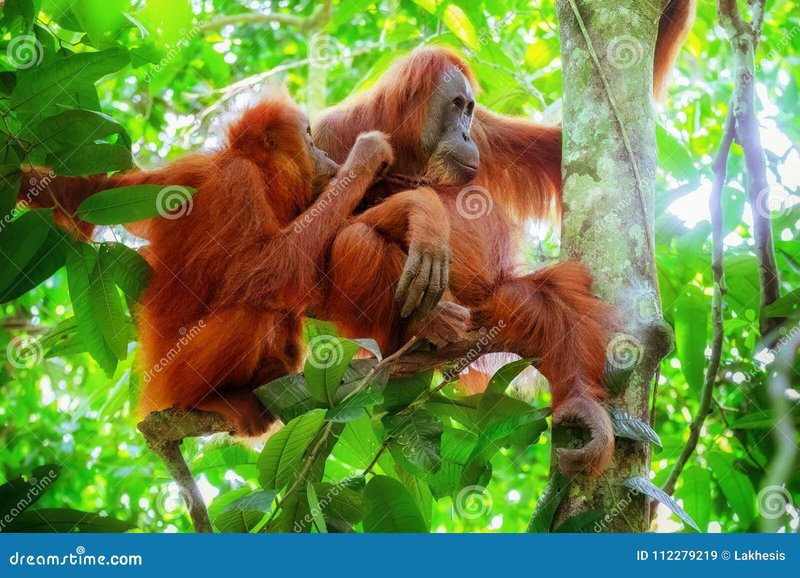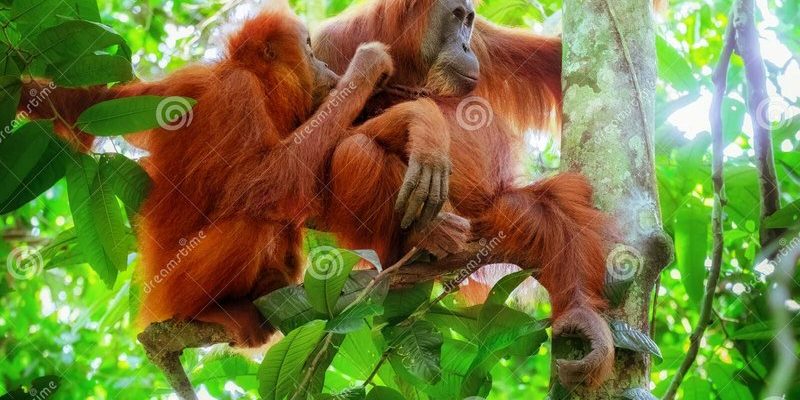
Raising young orangutans is much more than just providing food; it’s a comprehensive lesson in survival and social skills. Young orangutans depend heavily on their mothers, just like human babies do. They learn how to navigate their arboreal environments, find food, and prepare for the challenges ahead. So, let’s dive into how these incredible creatures parent their offspring in the wild, exploring everything from the early days of nurturing to the skills they impart for a successful future.
The Nesting Process: Creating a Safe Space
One of the first things you might be curious about is how orangutans start their parenting journey. When a mother orangutan gives birth, she carefully chooses a safe spot high in the trees, creating what we might call a “nest.” These nests are typically made from leaves and branches, offering a cozy and secure environment for her newborn.
What’s really interesting is that mothers will often build a new nest each night. This might sound like a lot of work, but it’s essential for keeping the baby safe from predators and the elements. Think of it as setting up a new bedroom every day! The mother’s dedication to constructing a sturdy nest not only ensures her baby’s safety but also teaches the little one the importance of a secure living space. As the baby grows, they’ll learn to help out, gaining skills that will serve them well in adulthood.
Nourishing Their Young: A Diet of Fruit and Love
Feeding a baby orangutan is no small task! In the wild, a mother’s diet consists mainly of fruits, leaves, and occasionally insects. For a newborn, this means a steady supply of *mother’s milk* during the first six months. After that, the mother starts to introduce solid foods, which can include ripe fruits like durian and jackfruit.
What’s fascinating is how mothers use their knowledge of the forest to teach their young about food sources. They’ll often take their babies on foraging trips, showing them what’s edible and what to avoid. Imagine a mother taking her little one by the hand, pointing out bright, juicy fruits and explaining, “This one is delicious!” In this way, orangutan mothers not only nourish their infants but also pass on valuable lessons about survival in their lush habitat.
Learning Through Play: The Importance of Social Skills
Orangutan younglings learn a lot through play, much like human children. It’s during these playful moments that they develop their physical skills and social behaviors. Young orangutans often engage in mock wrestling, swinging from branches, and exploring their surroundings under their mother’s watchful eye.
These playful interactions are crucial for developing coordination and balance, which are vital for climbing and moving through the trees later in life. You might be wondering why mothers allow their babies to roam and play. Here’s the thing: it’s not just fun and games! This playtime encourages confidence and independence. Plus, it strengthens the bond between mother and child, allowing them to communicate through gestures and sounds.
The Role of Independence: Gradual Separations
As baby orangutans grow, a mother will begin to encourage independence. Typically, this starts around four to five years old. At this stage, mothers will still be close by, but they’ll allow their young to explore more on their own. Picture a parent standing back while their child rides a bike for the first time—nervous yet proud.
This gradual separation is essential for the young orangutan’s development. They need to learn how to navigate their environment without constant supervision. Mothers teach them important skills like how to find food, build nests, and interact with other orangutans. The transition to independence can take several years, and each mother has her own style, adjusting her approach based on her baby’s personality and comfort level.
Mother-Infant Bond: A Lifelong Connection
One of the most heartwarming aspects of orangutan parenting is the bond between mother and infant, which lasts much longer than in many other species. In fact, young orangutans typically stay with their mothers for around six to seven years, learning everything they need to survive. This long period allows them to absorb their mother’s knowledge and experience.
You might be surprised to learn that this bond doesn’t just end when they reach independence. Mother orangutans maintain connections with their offspring for years to come. Even after they’ve moved on, young orangutans might return to their mothers for guidance or assistance. This lifelong relationship emphasizes the deep emotional connections that exist in the animal world, showcasing the intelligence and sensitivity of orangutans.
Challenges Faced by Orangutan Mothers
Unfortunately, raising young orangutans in the wild isn’t always easy. Honestly, there are numerous challenges that these mothers face. Habitat loss due to deforestation, illegal hunting, and climate change are significant threats to their survival. As their home disappears, so do the resources they need to nurture their young.
Moreover, young orangutans are vulnerable to predators and other dangers, making the mother’s protective instincts even more crucial. You might be wondering how mothers cope with these challenges. They adapt by teaching their young to be vigilant and resourceful. Despite the difficulties, orangutan mothers display incredible resilience, showing that nurturing can thrive even in tough circumstances.
Conservation Efforts: Supporting Orangutan Families
Given the challenges orangutan families face, conservation efforts play a vital role in ensuring their survival. Numerous organizations are working to protect their natural habitats and raise awareness of their plight. These efforts can include creating protected areas, educating local communities, and rehabilitating rescued orangutans.
Supporting these initiatives is essential for giving future generations of orangutans the opportunity to thrive. By preserving their environment, we’re not just protecting a species; we’re also ensuring that the unique bond between mother and baby continues for years to come. It’s a collective responsibility, and every little bit helps!
In conclusion, *Sumatran orangutans* exhibit fascinating and complex parenting behaviors that highlight the depth of their intelligence and emotions. From building nests to fostering independence, these mothers navigate the challenges of raising their young with grace and determination. As we learn more about their lives in the wild, it becomes clear that supporting and protecting these magnificent creatures is essential—not only for their future but for the health of our planet as well.
By understanding their experiences, we can appreciate the beauty of the natural world and the vital connections that bind us all together.

